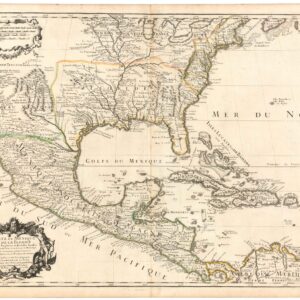An unrecorded wall map from pre-statehood New Mexico.
Powell & Kingman’s Map of Southwestern New Mexico
Out of stock
Description
No institutional holdings or records on the private market.
The most detailed map of a region of New Mexico to that date.
A remarkable and unique map of southwestern New Mexico from 1883, displaying the region in the process of transformations brought on by the incorporation of the territory following the Mexican-American War, the arrival of masses of troops and fortifications during the U.S. Civil War, and the alteration of the landscape brought about by mining and railroads.
The map is overlaid with a surveying grid forming squares, many of which are themselves subdivided by a similar grid on a smaller scale. Correction lines note where later surveys modified lines drawn by their predecessors. The Rio Grande runs prominently along the right side of the map, while a series of mountain ranges are denoted, including the Continental Divide. The top-left portion of the map is now the Gila National Forest.
Valleys, rivers, roads, railways, and other features are indicated in great detail, along with straightforward notes about the location of silver mines, water, wells, ranches, “good grass,” and so on. Many though not all the towns shown here still exist, while others appear to have simply been named after the owner of the land (Patterson’s, Crawford’s, etc.).
Prior to the Mexican-American War, this region was known to the Spanish and then Mexicans as especially treacherous (the “Jornada del Muerto” road connected it to lands further south), both due to the climate and the vulnerability of travelers to Apache and Navajo raiders. Socorro was the earliest Spanish settlement in the region but was abandoned by them for more than a century following the Pueblo Revolt of 1680.
During and after the Mexican-American War, U.S. troops renovated Mexican forts or built new ones nearby, and more fortifications were built during the Civil War. Both the Union and Confederacy laid claim to the New Mexico Territory (significantly larger than today’s state) and the rebels launched an ambitious military campaign in 1862 to control the new southwestern territories. The Confederates moved up the Rio Grande and won a battle at Valverde, just outside Fort Craig at top-right, but failed to take the fort or capture the Union force. After outrunning their supply lines and encountering Union reinforcements, the Confederates were forced to retreat to Texas.
The prevalence of U.S. military reservations and silver mines here gives a clear indication of the endeavors undertaken by the American settlers in the region. Though a “Mexican Settlement” is noted near San Francisco (now San Francisco Plaza) as well as a “Mormon Settlement” further south, there is little direct evidence of the Apache, Navajo, and other Native American inhabitants of the territory. In the years prior to this map’s production, the U.S. military “pacified” the region, forcing the Navajo and other groups off their ancestral lands and onto reservations, usually on the “military reservations” surrounding forts. Some Native American communities, especially those living at higher elevations, managed to remain on a portion of their lands (while still facing tremendous pressures of ecological strain and cultural assimilation), such as the Pueblo of Zuni, seen here just east of Deming.
Railroads also transformed the region, drastically cutting transportation times, facilitating the arrival of settlers, allowing for the extraction of resources (especially silver) on an industrial scale, and aiding the U.S. military’s control of the region. The well-known Southern Pacific and the Atchison, Topeka and Santa Fe Railway are present here, along with branch lines.
Early Maps of New Mexico
When established in 1850, the New Mexico Territory included most of the modern-day state, plus much of Arizona and portions of Colorado and Nevada. The borders changed regularly over the following decades due to border disputes, the creation of new territories, and the Gadsden Purchase (which included much of the territory shown here). “Anglos” began migrating in large numbers to the territory, establishing ranches and mining operations and causing friction with Native Americans and the previously-Mexican citizens who remained in the territory. Large areas were sparsely populated and detailed survey work was difficult to carry out given the climate, elevation, and interruption caused by military conflict.
Nonetheless, a range of military and civil topographical engineers, Indian agents, and adventurers of various stripes contributed to improved maps in these decades. The result was that by the 1870s, more detailed survey maps appeared with subdivisions and correction lines (not to correct mistakes, exactly, but added at regular intervals to account for the curvature of the Earth in drawing a grid). An 1866 General Land Office map (“Sketch of the Public Surveys In New Mexico & Arizona”), Morley’s 1873 map (“Morley’s Map of New Mexico. Compiled from the latest Government surveys…”), and Hayt’s c. 1875 map (“Hayt’s map of New Mexico,” compiled by the same Kingman who drafted the present map) stand out in this regard. Still, the present map provides a level of detail that far surpasses its predecessors and was, to our knowledge, the most detailed map of a region of New Mexico to that date.
Census
This map was drafted by E. Kingman, Jr. and printed by Powell & Kingman. It appears to be a unique example of this map; we are unable to locate any other instances of this map in institutional collections or on the market.
Cartographer(s):
E. Kingman, Jr. (active c. 1870 – 1884) was a surveyor active in New Mexico and Arizona who drafted some of the earliest detailed maps of the territories.
Condition Description
Good. Areas of wear and discoloration, especially around the margins. Professionally restored and re-backed.
References





